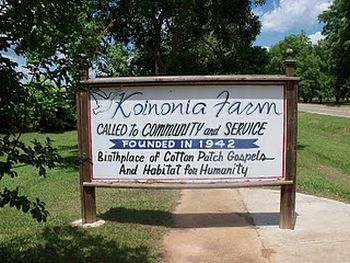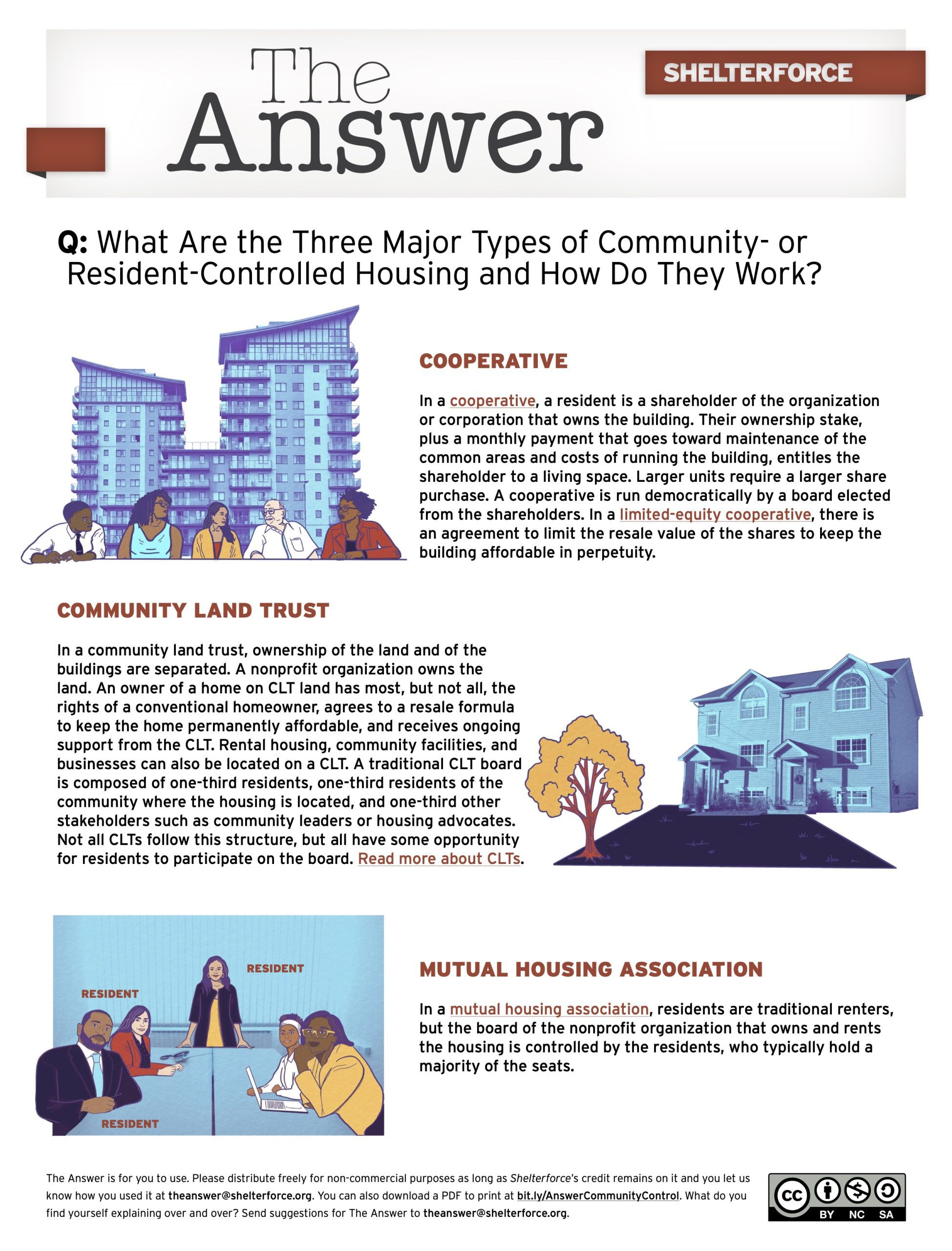Though they started at the same place around the same time, community land trusts and Habitat for Humanity soon went their separate ways. In recent years, however, inventive practitioners have been quietly weaving these movements together. Over 50 Habitat-CLT partnerships have been created to date.
Some of these partnerships are “external,” each partner bringing different resources to the task of lifting low-income families into homeownership. The CLT provides the land, while the Habitat affiliate builds the house and offers a zero-percent mortgage to the homebuyer. The CLT and the affiliate then share responsibility for post-purchase stewardship.
Other partnerships are “internal,” where the Habitat affiliate operates its own program of ground leasing or establishes its own CLT subsidiary.
There is a practical impetus to these partnerships, each party contributing something tangible that the other lacks. But there are intangibles as well, each reminding the other of principles and practices that once grounded their movements and nurtured their growth.
The Koinonia Connection
Between 1956 and 1968, the men and women who created New Communities Inc., the inspiration for every CLT that followed, were regular visitors to Koinonia Farm, an intentional Christian community near Americus, Georgia. The same was true for the people behind Koinonia Partners, the prototype for Habitat for Humanity. The paths of these pioneers almost certainly crossed, although it is not known how often, nor how much they may have influenced one another. All we know for sure is they all interacted with Clarence Jordan, Koinonia’s leader, who welcomed them to his table, happily debating their visionary schemes – and his own.
On October 21, 1968, Clarence mailed out a mimeographed letter to some 2000 Friends of Koinonia, announcing three initiatives for taking Koinonia’s ministry in a new direction. One of them was Koinonia Partners, a vehicle for developing cooperatively owned enterprises and individually owned houses on land leased from a nonprofit entity, which Clarence called the Fund for Humanity. Given his close relationship with the civil rights activists then engaged in creating New Communities, it is not surprising that some of the “partnership principles” put forward by him closely resembled components later incorporated into CLTs.
The movements that emerged out of Koinonia Partners and New Communities soon diverged, despite sharing both founders and features. There was never a falling out. Habitat for Humanity and community land trusts simply evolved along different lines, developing separate identities, separate constituencies, and separate sources of institutional support.
Back to the Future
Today, as practitioners strive to combine selected elements of Habitat for Humanity and the CLT, they are creating something new, but they are also reviving something old. These partnerships resurrect aspects of Clarence Jordan’s original vision that are frequently forgotten.
Leasing community-owned land. Habitat-CLT partnerships draw upon decades of CLT experience in leasing land for affordable housing. This is a practical contribution to the partnership’s success, but there is a moral dimension as well. As Clarence declared in his seminal letter, land must be “freed from the evils of speculation.” He proposed a new form of tenure for farming, industry, and housing alike: “all land will be held in trust by the Fund for Humanity, but will be used by the partners free of charge. Thus, usership will replace ownership.” The first housing completed by Koinonia Partners was constructed on lots previously sold by Koinonia Farm, but the next 22 houses were developed according to Clarence’s “partnership principles.” The land underneath was owned by the Fund for Humanity and leased for a nominal fee to the families buying these houses.
Preserving community-donated capital. Habitat-CLT partnerships bring a second strategy to the fore, a mechanism for preserving the community’s contribution; i.e., the private donations and public subsidies that make homes affordable for low-income families. Here, too, Clarence Jordan’s voice can be heard. According to his 1968 epistle, not only would the land be owned by the Fund for Humanity, so would the capital contributed to the partnership enterprises. The Fund would be “self-generative and ever expanding.” It would “give away no money.” These financial resources would not be used to enrich a fortunate few who had essentially won the lottery by purchasing and reselling a partnership home. They were to be stewarded for the benefit of future generations.
Sharing property-based wealth. Habitat-CLT partnerships also provide a durable mechanism for the poor to share their good fortune with others. This was perhaps the most challenging aspect of Clarence Jordan’s original vision for Koinonia Partners, for he suggested it wasn’t just the rich who should share their surplus with the poor; the poor should do so as well. The poor should have an opportunity to give back to the community that had lifted them into better housing. In his words, the partner families “will be encouraged to share at least a part of the savings on interest with the Fund for Humanity.” How was this to happen? The families would be “strongly encouraged, though not required, to contribute as liberally as possible to the Fund so as to keep enlarging it and making more capital available to others.” It was the right thing to do, so these homeowners would willingly do it.
Community land trusts have never had Clarence’s confidence that people will “do the right thing” when reselling homes that market forces may have made quite valuable. Instead of relying on homeowners to voluntarily donate (or forego) some of their equity at resale, a CLT creates a contractual regime through which most of the appreciation and all of the subsides are locked into the home, reducing its price for the next low-income homebuyer.
CLTs also realize that low-income homeowners often lack the wherewithal to complete major repairs. Many CLTs have established “stewardship funds,” therefore, collecting monies on a monthly basis that are set aside for future capital needs, keeping the home in sound condition for subsequent owners. Both mechanisms are less voluntary than Clarence might have liked, but they dependably deliver the sharing of wealth that he desired.
Learning Together
These practices, perfected by CLTs over the years, have proven to be a comfortable fit with programs and policies already embraced by Habitat. In January 2010, Habitat for Humanity International published a new Subsidy and Sustainability Policy, urging affiliates to take better care of the community’s contribution. And many affiliates have been making post-purchase stewardship a higher priority, especially with regard to improving the durability and maintenance of Habitat houses.
It would be a mistake to believe, therefore, that it is only by partnering with a CLT – or by incorporating CLT elements into their existing programs – that a Habitat affiliate is put in touch with partnership principles espoused long ago. It is equally mistaken to assume that the teaching that occurs in a Habitat-CLT partnership flows only one way.
Community land trusts reap material benefits from partnering with a Habitat affiliate, chiefly the chance to build more houses and to serve families at a lower level of income. But for CLTs, too, there are intangibles. These partnerships reaffirm the utility and morality of community ownership of land, which some CLTs have abandoned in favor of affordability mechanisms more likely to attract private financing.
These partnerships reconnect CLTs with faith-based institutions that were once a powerful source of energy and support for the CLT movement.
And these partnerships remind CLTs of the value of engagement, where “partner families” are active participants in the delivery of housing services, not passive clients.
Habitat affiliates that partner with a CLT are not alone, therefore, in being reminded of their origins. CLTs may have a similar experience. That is part of what makes these partnerships so compelling. They improve the productivity and sustainability of homeownership programs already in place by reacquainting practitioners with people and principles that breathed life into both movements nearly forty years ago.
(Photo: public domain)






Comments